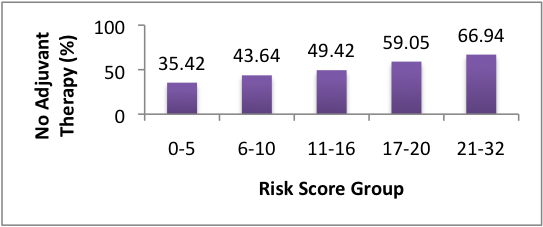Adjuvant Therapy for Resectable Pancreatic Cancer: A Simple Prediction Rule
J. K. Smith, S. C. Ng, J. P. Simons, Z. Zhou, S. A. Shah, T. P. McDade, J. F. Tseng, University of Massachusetts Medical School, Surgical Outcomes Analysis and Research, Worcester, MA
Instructions
Follow the steps below to calculate the risk of a patient not being able to complete adjuvant therapy following a pancreatic resection for cancer.
Step 1. Calculate Charlson comorbidity score
Indicate "yes" for the comorbidities that the patient has. This validated algorithm (Charlson, ME et al. J Chron Dis 1987; 40(5):373-83.) assigns a point value to the various diseases. The patient's raw score will then be reassigned into the collapsed Charlson score groups for use in the risk score calculation. Group 1 is a score of zero, Group 2 is a score of 1 or 2, Group 3 is a score of 3 or higher.
|
Comorbidity |
Points |
|
| AIDS | ||
| Cerebrovascular Disease | ||
| Chronic Pulmonary Disease | ||
| Congestive Heart Failure | ||
| Connective Tissue/Rheumatic Disease | ||
| Dementia | ||
| Diabetes Without End Organ Damage | ||
| Diabetes With End Organ Damage | ||
| Hemiplegia | ||
| Liver Disease Mild to Moderate | ||
| Liver Disease Severe | ||
| Myocardial Infarction | ||
| Peripheral Vascular Disease | ||
| Renal Disease | ||
| Ulcer Disease | ||
| Charlson Group Score | ||

Fig. 1: Risk of not receiving adjuvant therapy
As demonstrated in the above graph, as the risk score increases, the probability that the patient does not receive adjuvant therapy also increases.
|
10/28/2015: We are happy to announce the first issue of the Department of Surgery newsletter. This is a bi-monthly publication that highlights what we are working on, new news, research projects as well as upcoming changes. We will have interviews, articles and upcoming events in every issue. » Click to read more news about UMass Surgery
|
